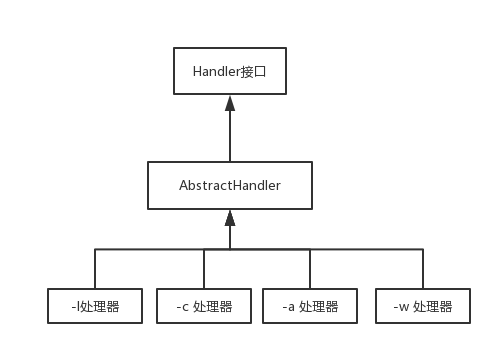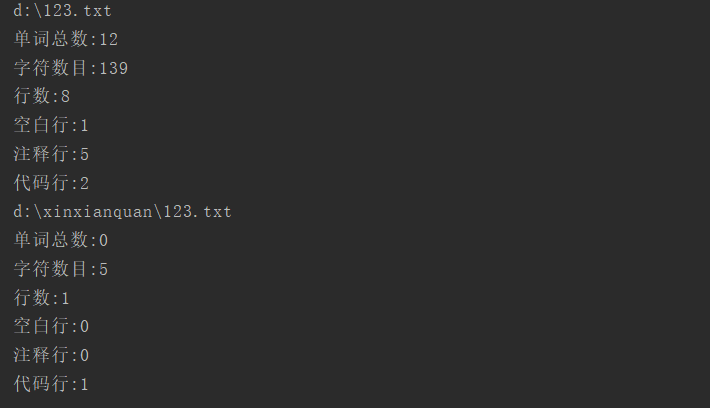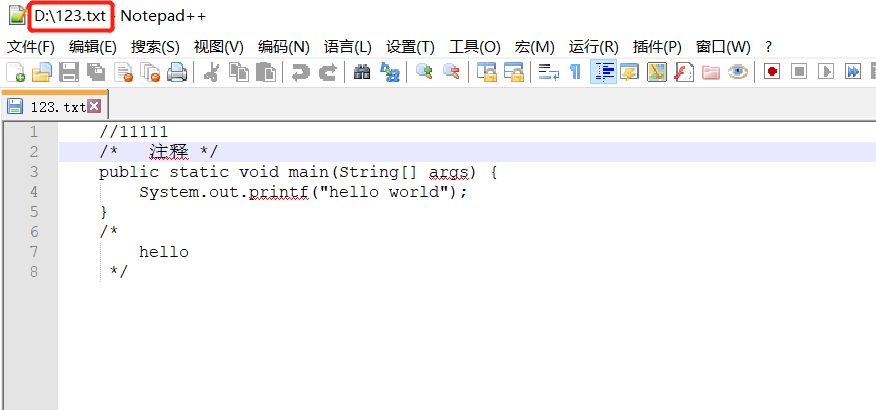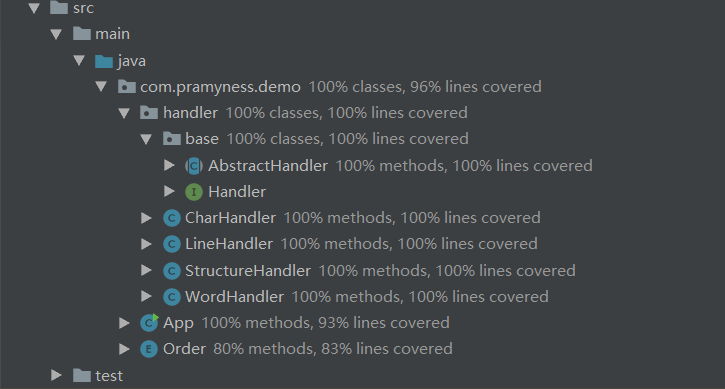要求
-
基本要求
-
[x] -c 统计文件字符数 (实现)
-
[x] -w 统计文件词数 (实现)
-
[x] -l 统计文件行数(实现)
-
-
扩展功能
- [x] -s 递归处理目录下符合条件得文件(实现)
- [x] -a 返回文件代码行 / 空行 / 注释行(实现)
- [x] 支持各种文件的通配符(*,?)(实现)
-
高级功能
- [ ] -x 图形化界面(未实现)
GitHub仓库:https://github.com/Pramy/wc
设计
按照需求可以分为3个模块,1:对文件内容的统计,2:对输入指令的解析,3:批量操作
第一个模块:可以将文本一行一行分析得到自己的结果,可以将一种指令对应一个处理器(handler),在程序启动的时候加载所有处理器,然后针对不同的指令调用不同的处理器,并且应该有获取结果的接口,然后再对各种处理进行抽象,抽象出Handler接口。
第二个模块:第二个模块加上第一个模块就需要相对调整第一个模块,根据输入的指令解析后,得到各种各样的处理器,然后把它连成一条处理链,将需要分析的一行字符串,从头到尾依次处理,也应当有一条获取结果的调用链,从头到尾一次获取处理结果,然后再对模块一的Handler进行抽象,得到AbstractHandler,各种处理器应当继承这个抽象处理器,然后对输入的命令进行匹配,查找
理器的架构图如下

第三个模块:根据-a命令来设计批量分析功能
代码
启动类App.java
public class App {
private static final Map<String, Handler> MAP;
private static boolean IS_RECURSION = false;
private static String NAME;
private static Handler HEAD;
//将处理器存在map中
static {
MAP = new HashMap<>();
MAP.put(Order.L.getCommand(),new LineHandler());
MAP.put(Order.W.getCommand(),new WordHandler());
MAP.put(Order.C.getCommand(),new CharHandler());
MAP.put(Order.A.getCommand(),new StructureHandler());
}
public static void main(String[] args) throws IOException {
File file = build(args);
//对于通配符的处理
String name = file.getName();
if (file.isDirectory()) {
NAME = ".*";
} else {
file = file.getParentFile();
NAME = name.replaceAll("\\.", "\\\\.").replaceAll("[*?]", ".*");
}
if (file == null || !file.exists()) {
throw new RuntimeException("文件:不存在");
}
File[] files = file.listFiles();
if (files != null) {
for (File file1 : files) {
read(file1);
}
}
}
/**
* 处理文件
* @param file 需要分析的文件
* @throws IOException io
*/
private static void read(File file) throws IOException {
if (file.isFile() && file.getName().matches(NAME) && file.canRead()) {
System.out.println(file.getPath());
FileReader fileReader = new FileReader(file);
BufferedReader bf = new BufferedReader(fileReader);
String s;
if (HEAD != null) {
while ((s = bf.readLine()) != null) {
//1.将读到的一行字符串从头带尾依次处理
HEAD.handle(s);
}
//2.处理完成后获取处理结果
HEAD.get();
//3.清除处理结果以便接下来的处理
HEAD.clear();
}
}
//判断是否要递归处理
if (IS_RECURSION) {
File[] files = file.listFiles();
if (files != null) {
for (File file1 : files) {
read(file1);
}
}
}
}
/**
* 构建处理链,然后分析是否要递归查找
* @param args orders
* @return file
*/
private static File build(String[] args) {
Handler pos = null;
for (int i = 0; i < args.length - 1; i++) {
//对指令-s 的处理
if (args[i].equals(Order.S.getCommand())) {
IS_RECURSION = true;
} else {
Handler handler = MAP.get(args[i]);
if (handler != null) {
if (HEAD == null) {
HEAD = handler;
} else if (pos instanceof AbstractHandler) {
//构建链表
((AbstractHandler) pos).setNext(handler);
}
pos = handler;
} else {
throw new RuntimeException("参数:" + args[i] + "无效");
}
}
}
return args.length >= 1 ? new File(args[args.length - 1]) : new File("");
}
}
AbstractHandler
@Setter
private Handler next;
//调用链的核心代码,只需要子类实现doHandle方法既可以实现链式调用
@Override
public void handle(String line) {
doHandle(line);
if (next != null) {
next.handle(line);
}
}
protected abstract void doHandle(String line);
AbstractHandler是调用链的核心类。如果依次有处理器A->B->C,在调用了A的handle()方法后,然后A,B,C的doHandle()方法也会依次被调用
统计字符-c :CharHandler
@Override
public void doHandle(String line) {
//windows \r\n
//Mac \r
//Unix \n
count += line.length() + System.lineSeparator().length();
}
count为字符数,一行字符串后面并没有算上回车符,然后根据不通过的操作系统补上相应的数量
统计单词-w:WordHandler
@Override
public void doHandle(String line) {
String s = line.replaceAll("[\\p{Nd}\\u4e00-\\uffe5\\p{Punct}\\s]", " ");
count += StringUtils.split(s, " ").length;
}
将一行中的数字和和中英文标点符号和中文替换为" " ,然后按照" "切分得到的数量就是单词数
统计行数-l:LineHandler
每一次++就可以,代码过于简单就不贴了
统计复杂结构 -a:StructureHandler
public class StructureHandler extends AbstractHandler {
//空行
private int emptyLine;
//代码行
private int codeLine;
//注释行
private int annotationLine;
//注释开始标志
private boolean isContinue;
/**
这种属于多行注释
* @param line line
*/
@Override
protected void doHandle(String line) {
//如果进入了多行注释/* 那必须得匹配*/才可以结束,并且/* */中间的所有行都是注释行
if (isContinue) {
if (line.matches(".*\\*/\\s*")) {
isContinue = false;
}
annotationLine++;
} else {
//匹配全部是空格或格式控制字符,如果包括代码,则只有不超过一个可显示的字符
if (StringUtils.isAllBlank(line) || line.matches("\\s*\\p{Graph}\\s*")) {
emptyLine++;
//匹配单行注释// 和/* */
} else if (line.matches("\\s*}?\\s*//.*") || line.matches(".*/\\*.*\\*/.*")) {
annotationLine++;
//匹配/*
} else if (line.matches(".*/\\*.*")) {
isContinue = true;
annotationLine++;
//匹配代码行
} else {
codeLine++;
}
}
}
}
首先判断是不是多行注释,如果是一定要匹配到结尾符号*/才算结束,如果不是多行注释,就对每一行的内容进行分析
测试
在命令行输入
java -jar count-1.0-jar-with-dependencies.jar -w -c -l -a -s d://123.txt
然后得到结果

123.txt文件

代码覆盖率
进行代码覆盖率测试
运行命令(统计d盘下面所有的txt文件)
-w -c -l -a -s d://*.txt


整体代码覆盖率是92%
PSP
| PSP2.1 | Personal Software Process Stages | 预估耗时(分钟) | 实际耗时(分钟) |
|---|---|---|---|
| Planning | 计划 | 30 | 60 |
| · Estimate | · 估计这个任务需要多少时间 | 30 | 60 |
| Development | 开发 | 690 | 1415 |
| · Analysis | · 需求分析 (包括学习新技术) | 30 | 60 |
| · Design Spec | · 生成设计文档 | 30 | 150 |
| · Design Review | · 设计复审 (和同事审核设计文档) | 60 | 120 |
| · Coding Standard | · 代码规范 (为目前的开发制定合适的规范) | 30 | 20 |
| · Design | · 具体设计 | 30 | 120 |
| · Coding | · 具体编码 | 240 | 600 |
| · Code Review | · 代码复审 | 30 | 45 |
| · Test | · 测试(自我测试,修改代码,提交修改) | 240 | 300 |
| Reporting | 报告 | 80 | 80 |
| · Test Report | · 测试报告 | 20 | 40 |
| · Size Measurement | · 计算工作量 | 30 | 20 |
| · Postmortem & Process Improvement Plan | · 事后总结, 并提出过程改进计划 | 30 | 20 |
| 合计 | 800 | 1555 |
总结
从新学了一遍正则表达式,由于一开始思路没有清晰,没有理解清楚需求,导致设计有点偏差,导致花费了大量时间在写无用代码上,造成了极大的浪费,在写代码的过程中希望写的高效经常尝试改写代码,在方案上面一开始没有定夺下来,也可能这方面用得比较少或者缺乏经验,导致走了很多弯路,在这个作业中,重新认识到Java一些比较有用并且高效的知识,收获还是蛮多的![]
来源:https://www.cnblogs.com/pramy/p/9607743.html